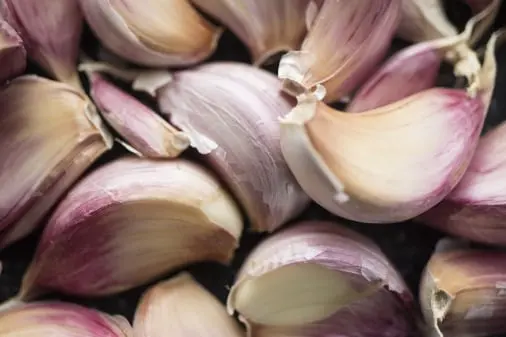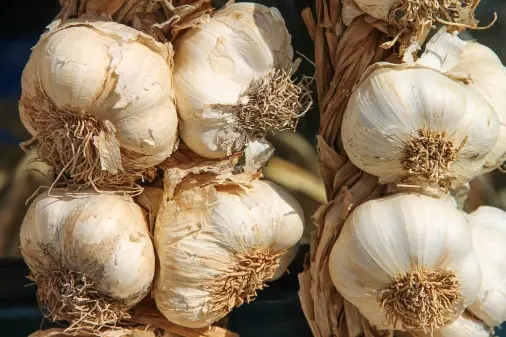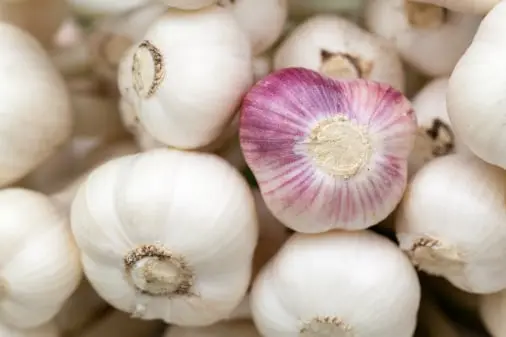Asparagus quality inspection app with AI for asparagus quality:
Garlic quality inspection app with AI for easy garlic quality management for consistent garlic quality control, faster garlic packing, easy garlic traceability and reduced garlic waste.

Garlic Quality inspections during production
View App Specifications.
In the present study, we examined the phenotypic diversity of Greek garlic (Allium sativum L.) genotypes using morphological descriptors derived from IPGRI and UPOV. Thirty-four garlic genotypes were cultivated at two different locations: (a) Velestino, Magnesia, Region of Thessaly, and (b) Kavasila, Ilia, Region of Western Greece. The garlic genotypes were characterized using twenty-seven morphological descriptors and four quantitative characters, namely bulb dry matter, chlorophyll content in the leaf, yield and total soluble solids (°Brix) of plants and raw bulbs. The Shannon–Weaver (H′) phenotypic diversity index varied among the genotypes, although identical mean values (0.79) were recorded for both fields. Traits, such as flowering stem length, bulb skin color, skin color of the clove presented low (H′) values indicating a high coefficient of heritability and less environmental effect. Principal component analysis based on morphological characters showed that the first seven axes could explain 71.49% and 75.86% of total variation for Kavasila and Velestino fields respectively. Significant differences were also observed among the garlic genotypes for the quantitative characters studied. Furthermore, significant statistical correlations were recorded for specific characters between the two cultivation sites e.g. yield with weight of cloves (r = 0.55 and r = 0.62) and number of cloves per bulb with weight of cloves (r = −0.51 and r = −0.55), which could be exploited further in future breeding programs. In conclusion, the high phenotypic diversity observed among the garlic genotypes could be attributed to various factors such as the genotype, the cultivation practices and the environmental conditions.

Daily Garlic packhouse hygiene checklist
U.S. No. 1 consists of garlic of similar varietal characteristics which is mature and well cured, compact, with cloves well filled and fairly plump, free from mold, decay, shattered cloves, and from damage caused by dirt or staining, sunburn, sunscald, cuts, sprouts, tops, roots, disease, insects, or mechanical or other means. Each bulb shall be fairly well enclosed in its outer sheath. Unless otherwise specified, the minimum diameter of each bulb shall be not less than 1-1/2 inches.
a. Tolerances. In order to allow for variations incident to proper grading and handling, the following tolerances, by weight, are provided as specified:
1. For defects. Ten percent for garlic in any lot which fails to meet the requirements of this grade, including therein not more than 2 percent for garlic which is affected by decay.
2. For size. Five percent for garlic in any lot which fails to meet any specified size.

Garlic Quality control & management
Garlic-specialized metabolites contribute to both spicy flavor and healthy function of garlic. Their accumulation pattern and regulatory mechanism vary greatly at different environments and maturities. Herein, metabolomics models were built to evaluate and predict the quality and chemical composition variances of four garlic varieties in two regions at six growth stages. A total of 91 metabolites were identified, and their accumulation pattern during growth in three varieties of garlic in Shandong was similar but obviously distinct from that planted in Heilongjiang. Active metabolism for organosulfur compounds and amino acids was observed, and most metabolites with the “γ-glutamyl-” group were the storage compounds of nitrogen and sulfur in garlic because they increased remarkably during growth. The levels of functional components in garlic varied among different stages, and reliable prediction models for these compounds were provided, which may give a new idea for the estimation of garlic quality and confirmation of the best harvest time.

Garlic Supplier quality inspection & management
Identification of main chemical constituents in garlic by UHPLC Q-Exactive Orbitrap MS (Table S1), detailed websites from MoNA that support the identification of 12 compounds in garlic (Table S2), contents of 29 targeted compounds in garlic among different growing stages (Table S3), agro-morphological traits of garlic in different growing stages (Table S4), parameters of OPLS regression models for characteristic components in garlic based on agro-morphological traits (Table S5), observed and predicted concentrations and RE between them for the testing set predicted by OPLS regression models (Table S6), VIP values for agro-morphological traits in OPLS regression models for allicin and a total of seven flavor precursors in ZP, J3, J4, and BP (Table S7), workflows and parameters of Compound Discovery 3.0 analysis (Figure S1), MS/MS spectra of 29 compounds identified in the garlic sample and mzCloud (Figure S2), structural characterization for 13 compounds in garlic (Figure S3), TIC obtained by UHPLC Q-Exactive Orbitrap MS of extracts from garlic bulbs of ZP, BP, J3, and J4 at weeks 1, 4, and 6 (Figure S4), and pathway analysis showing changing metabolism during garlic development (Figure S5) (PDF)
GARLIC QUALITY MANAGEMENT
ARLIC QUALITY AS A FUNCTION OF SEED CLOVE HEALTH AND SIZE AND SPACING BETWEEN PLANTS